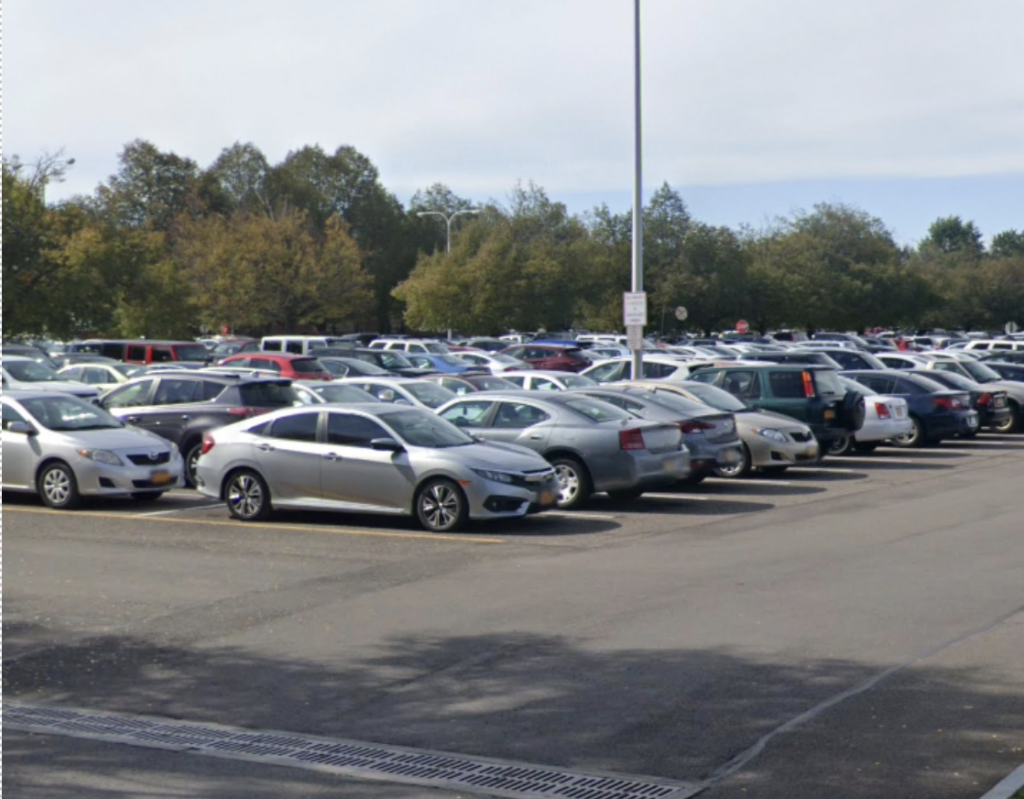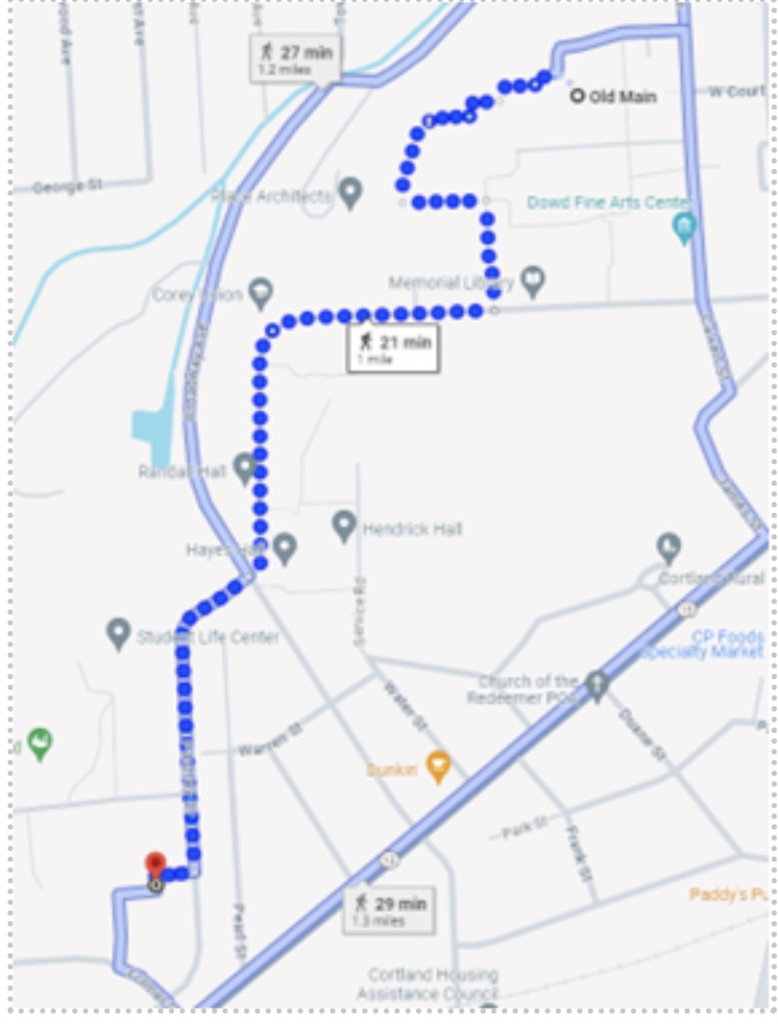By: Branden Riley and Juniper Lasky
Recent changes to SUNY Cortland’s parking policies have left half of its residents further away from their cars, a mile away in some scenarios. Students now realize it is one of the things the school made life very difficult.
At the beginning of 2023 Fall, SUNY Cortland made new changes that are now criticized as being lopsided. They do little to improve the overall problem but favor either commuter or residential students at the sacrifice of the other, as has happened many times in the past.
Back in 2020, the school administration laid out a plan to create a new parking lot for students. “The Facilities Planning, Design, And Construction Office eagerly awaits a project to pave a new parking lot in a field between the SUNY Cortland Stadium Complex and the existing Route 281 lot,” the Communication Office announced. “This will add 140 new spaces.”
Another addition was the partnership with First Transit, the City of Cortland’s public bus service. Seven routes with fares were created. Students had the option to purchase a monthly pass for $45.
Credits to Junipstudios
Nevertheless, the students’ discontent grew in the next two years. In 2022 a petition created by Angelina Bucco was started on change.org titled “Open up more student parking on upper campus and STOP GIVING US TICKETS.”
“I don’t know one person who hasn’t gotten a ticket,” said Leanne Tallon, one of the signatories. “I’m tired of paying for a parking pass and not being able to park.”
Recent Modifications
The most recent changes were made against this backdrop. What has changed in 2023 Fall: Lot S-64 was flipped from residential to commuter and lot S-68 was flipped from commuter to residential. Both lots are heavily trafficked by students. Additionally in 2023 Spring, Neubig road added 90-minute parking.
“The lot changes kinda sucks for residential students,” said SUNY Cortland senior Matt Davis-Howard. “We gained a parking lot as commuters, and residential students are pushed further away.”
Matt is a senior in Cinema Studies who commutes. He isn’t unscathed from the new parking changes. “The change done to the hill (Neubig Rd), only allowing an hour and a half parking is horribly inconvenient,” said Matt. “You have a late class, half of those classes run longer than an hour-fifteen. It really isn’t fair to be subjected to tickets for one class.”
Student Opinions
Parking lots that weren’t directly affected by the change are starting to become more problematic. “There are times where I’ve been late to class, up in the double digits at least,” said Matt. “You go and look for a spot on the hill, nothing there, then you go into the commuter lot (SLC lot) and hope you find a spot there and then factor in a twenty-minute walk.

For commuter students who park in the SLC lot, their walk to commonly used classrooms on campus is an eighth of a mile or in some cases a full mile. For reference, a mile-long walk is 15-20 minutes long. This adds up over a day; many commuter students are walking anywhere between 2-2.5 miles. To do the math, commuter students are walking forty-five minutes to an hour every day they have classes.
“I lived in Hayes Hall, and often had to park in the 281 lot,” said SUNY Cortland Junior, Madeline Ruuge. “I would walk a mile to the closest dorm in the dark,”. Ruuge explained she would take a walk through a route that had scarce lighting for 20 minutes.

Madeline’s plight is due to the recent change to lot S-68. This lot sits between the football stadium and 281 was once a commuter lot. This means before the recent changes, the commuter students got the short end of the stick. Now, with these changes, it’s the residential students who are stuck with a mile walk to campus. Moreover, this change puts only two residential parking lots (S-57 and S-62) under a mile from the center of campus. This is all in spite of the fact that there are over 15 total lots within a mile of campus, with most of them standing as staff or metered/paid parking.
“I am disabled and recently got a ticket for using the faculty and staff lot next to my dorm,” said a residential student, Mol Pietarinen. “I had flu at the time and was at risk of fainting.” Even if Mol was able to walk to the closet residential lot, the odds are that the close lots would’ve been full. Then they would have to deal with the lots that are a mile away from campus.
Mol also has a lot to say about how difficult it is for some of the residential students who have off-campus jobs and need to access their cars much more often than residential students who do not. “…they should not be having to walk a mile and a half, every single day, to get to their cars, and then to get back to their dorms. The [On Campus] buses do not run late enough for most students, and most work schedules.” This also brings up the problem of the on-campus buses that are sent back to the garage for the day way too early in the night, which doesn’t help the students get back to campus late, whether that be for work reasons, or completely other reasons. This is another aspect of the parking situation that must be addressed.
What Can Be Done?
Matt, Madeline, and Mol along with hundreds of other students wish that SUNY Cortland would build more parking lots. However, SUNY Cortland doesn’t see this as an option. When asked if the college could build more parking lots, Associate Vice President for Facilities Management Zachariah Newswanger said, “It isn’t realistic. We don’t want the campus covered in asphalt,”. He added, “There’s just not a lot of real estate for new lots.”
A possible solution ironically lies in rearranging the lots again. For commuter students there once was a lot near what currently is the N-2 lot. This lot is closer to Old Main, Moffett, and Sperry. This would free up some room in the SLC lot for residential students. Another solution that could be considered would be to deny freshmen their cars. Many other campuses don’t let freshmen bring their cars, so why not here? On average, SUNY Cortland annually admits about 1,200 freshmen. Even if only a quarter of those students (~300 students) bring their cars, that could open another parking lot and help out residential students. It could also help to make the hill parking 90 minutes for those without a commuter pass, but 3 hours for the students who do have a commuter pass. Mol Pietarinen wraps up the current situation perfectly with this, “Cortland is not a walkable city… and it is ridiculous, that walking to CVS, is faster than walking to my car.”
With the recent changes, and everything in between, the parking problem hasn’t gotten any better, and students want to find a solution that benefits everyone. Matt expressed, “When it comes to the parking situation, there is no middle ground, it completely screws one group of people over in favor of the other. It’s unbalanced, to say the least.”